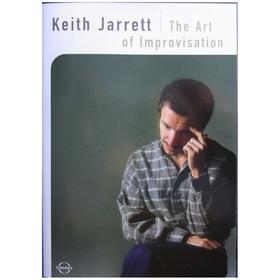Jazz on Film: Keith Jarrett – a sideman to the music

“When you improvise it’s the whole nine yards, all at the same times. It’s content, nuance, the way you play it, the subject itself, the dynamics, and the risk all at the same time.” –Keith Jarrett
Improvisation is the ability to compose and create music in the immediate moment. From Louis Armstrong to Charlie Parker to Sonny Rollins and beyond, for over a hundred years, improvisational geniuses have been jazz’s gift to the world. For most of his long career Keith Jarrett has been totally devoted to “The Art of Improvisation,” which is the title of a 2005 documentary, directed by Mike Dibb and produced by EuroArts Music International GmbH.
Jarrett has taken improvisation to places far beyond the reach of most players. As a child prodigy who had his first formal classical recital at age seven, a 2014 NEA Jazz Master who sells out concert halls across the world, Keith Jarrett has been a force of nature.
Anyone who’s ever heard him live would agree that Keith Jarrett is a genius. He also engenders deep loyalties. He has had the same producer and label, Manfred Eicher at ECM since 1972, the same tour director and manager is almost the same amount of time, and since he began leading his own bands, he has had only three drummers (Paul Motian, Jon Christensen, Jack DeJohnette) and bass players (Charlie Haden, Palle Danielsson, Gary Peacock).
The film follows a basic chronology of his life with one of his younger brothers providing insight into his early family life. As good documentaries should it offers fantastic and rare concert footage. We see clips of him in his early 20s with the Charles Lloyd quartet, playing electric piano and organ with Miles Davis, leading his American Quartet that featured Dewey Redman, Charlie Haden and Paul Motian, and his European Quartet with saxophonist Jan Garbarek. The film shares a sample of the Mozart duet he did in Japan with Chick Corea, with Chick commenting while watching the video of it. And of course, we’re treated to Keith performing both classical and jazz works as a soloist, with an orchestra, and as a trio (and even him playing soprano sax).
The film devotes much focus to his “Standards Trio” of Gary Peacock and Jack DeJohnette who have been playing together for over 30 years. Keith Jarrett is an artist with a reputation for bringing enormous integrity and high standards to his work and therefore does not suffer fools. For his solo performances, cough drops are passed out to audiences in the cold months, and he is loath to anyone attempting flash photography during his performances. Throughout the film, the interviewer, British author and pianist Ian Carr engages Keith in an openness that belies his prickliness and we even get glimpses on his sense of humor, and especially his tremendously honest self-awareness. It is when he talks about improvisation and the service he, Gary and Jack bring to the music that the film elevates itself beyond a simple documentary. There is an almost zen-like quality to how they approach their playing. Finding the silences between the notes, their sensitivity to the not-doing that facilitates the doing, and letting the music, not their prodigious techniques, tell them what to play.
Although he wouldn’t use the word, being a master of both classical and jazz, Jarrett contrasts the two this way. “Jazz is expansive while classical is constrictive. The notes are already down on the paper and I know everything that is going to happen. Not so in jazz.” He describes how in improvisational playing it all happens at once. Everybody is listening intently and the mind and the intuition are both operating within a deep trust among the players to play what occurs simultaneously, in that very moment. Jarrett explains further that he sees himself not as a leader but rather that the trio are all sidemen to the music itself, willing and able to go wherever it leads, never relying on favorite phrases or grooves, forgetting everything they already know in order to create in that moment. Bassist Gary Peacock remarked that he couldn’t count the number of times that they ran through songs during their sound check and then never played a single one during the concert. They see each performance as a blank canvas and their job is to take these standards, tunes that they’ve each played thousands of times already and find the notes and the feeling that they didn’t already know were there. To do that on a nightly basis, and over the course of decades is something akin to a basketball team being so in ‘the zone’ that they can’t miss and create a beautiful free-flowing movement game after game after game. The level of concentration, trust, and service to the music is just astonishing. Perhaps it is no wonder that when it comes to recordings, apart from a pair of duet records made with the late Charlie Haden, Keith Jarrett has preferred to put out live recording for the past 20 years, documenting only when magic was captured in a bottle.
There is some of that magic in this film and as we’re told by Manfred Eicher, he has perhaps 100 additional live recordings that they have not (as-yet) released. Who knows what other magic awaits fans of this singular talent.
Note: the film is available at the public library in Denver as well as on YouTube.
https://www.youtube.com/watch?v=vqQGdq2UAr0
Music used in the segment include “Close Your Eyes” (Keith Jarrett at the Blue Note, 1994) and “Lucky Southern” (Airto CD Free, 1972).
9(MDA3NDU1Nzc2MDEzMDUxMzY3MzAwNWEzYQ004))
Become a Member
Join the growing family of people who believe that music is essential to our community. Your donation supports the work we do, the programs you count on, and the events you enjoy.
Download the App
Download KUVO's FREE app today! The KUVO Public Radio App allows you to take KUVO's music and news with you anywhere, anytime!
